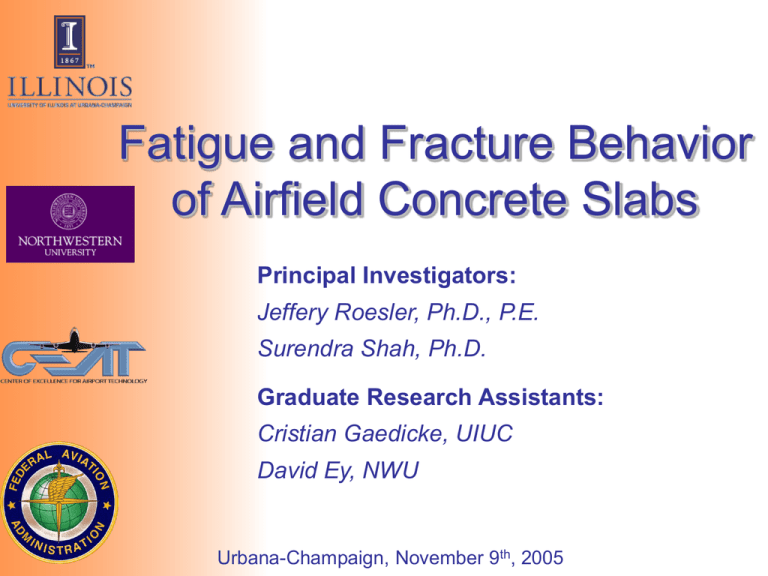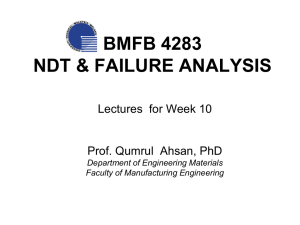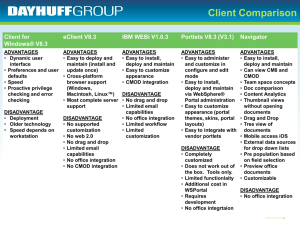Fatigue and Fracture of Concrete Slabs for Airfields
advertisement

Fatigue and Fracture Behavior of Airfield Concrete Slabs Principal Investigators: Jeffery Roesler, Ph.D., P.E. Surendra Shah, Ph.D. Graduate Research Assistants: Cristian Gaedicke, UIUC David Ey, NWU Urbana-Champaign, November 9th, 2005 Outline Objectives Experimental Design Experimental Results 2-D Fatigue Model Finite Element Analysis Application of FEM Model Fatigue Model Calibration Fatigue Model Application Summary The Future Cohesive Zone Model Research Objectives Predicting crack propagation and failure under monotonic and fatigue loading Can fracture behavior from small specimens predict crack propagation on slabs. Load CMOD Three point bending beam (TPB) Beam on elastic foundation Slab on elastic foundation Research Objectives Integrate full-scale experimental slab data and a 2-D analytical fracture model (Kolluru, Popovics and Shah) Check if the monotonic slab failure envelope controls the fatigue cracking life of slabs as in small scale test configuration. Load vs. CMOD for 63 mm depth beam Load vs. CMOD in 63 mm beam 2.5 2.5 2 1 Load (kN) Load (kN) 2 1.5 0.5 0 0 0.2 0.4 0.6 0.8 1 1.2 1.4 1.5 1 Cycle 1 CMOD (mm) Cycle 1024 0.5 Load vs. CMOD curve Load (kN) 4.5 0 4 0 3.5 3 2-D Model 2.5 2 1.5 1 0.5 0 0 0.1 0.2 0.3 0.4 0.5 0.6 0.7 0.8 0.9 1 CMOD (mm) Monotonic load 0.002 0.004 0.006 0.008 0.01 CMOD (mm) Fatigue load Experimental Design Beam Tests Simple supported beams: 2 beams, 1100 x 80 x 250 mm. 2 beams, 700 x 80 x 150 mm. 2 beams, 350 x 80 x 63 mm. • The beams have a notch in the middle whose length is 1/3 of the beam depth. Beams on clay subgrade: 2 beams, 1200 x 80 x 250 mm. 2 beams, 800 x 80 x 150 mm. 2 beams, 400 x 80 x 63 mm. • The beams have a notch in the middle whose length is 1/3 of the beam depth. Experimental Design Slab Tests Large-scale concrete slabs on clay subgrade: 2 slabs, 2010 x 2010 x 64 mm. 4 slabs, 2130 x 2130 x 150 mm. • The load was applied on the edge through an 200 x 200 mm. steel plate. • The subgrade was a layer of low-plasticity clay with a thickness of 200 mm. Concrete Mix Standard Paving Concrete: ¾” limestone coarse crushed aggregate, 100 mm slump and Modulus of Rupture 650 psi at 28 days Experimental Results Results on Beams Load vs CMOD in Simple Supported Beams Load (kN) Monotonic Load •Full Load-CMOD curve. •Peak Load. •Critical Stress Intensity Factor (KIC) . •Critical CTOD (CTODc). •Compliance for each load Cycle (Ci). 8 7 6 5 4 3 2 1 0 0 Load vs. CMOD Curve for Beams on Elastic Foundation 0.4 0.6 0.8 1 1.2 CMOD (mm) Load vs. CMOD for Beam on Elastic Foundation 10 9 8 B63 7 B150 6 B250 Load (kN) 7 Load (kN) 0.2 6 5 4 3 Compliance vs. load cycle 5 4 3 2 2 1 1 0 0 0 0.5 1 1.5 2 CMOD (mm) 2.5 3 3.5 0 0.2 0.4 0.6 CM OD (mm) 0.8 1 Beam FEM Setup Small Beam UIUC Testing Monotonic Results and Crack Length FSB 63 From FEM 0.03 y = 0.0006x - 0.008 R2 = 0.9972 Compliance 0.025 0.02 0.015 0.01 2.5 0.005 0 0 10 20 30 40 50 60 2 load (KN) Crack length (mm) From Testing 1.5 FSB 63b FSB 63c 1 Peak Load 2.5 0.5 2 Load (KN) 0 0 1.5 FSB 63B FSB 63C 1 0.5 0 0 0.01 0.02 0.03 CMOD (mm) 0.04 0.05 0.06 10 20 30 crack length (m m ) 40 50 60 Experimental Results Results on Beams Load vs. CMOD Fatigue Cycles in 63 mm beam 2.5 Cycle 1 Cycle 1024 Cycle 10240 Cycle 45568 2 Load (kN) Fatigue Load in FSB •Load vs. CMOD curves •Compliance vs. number of cycles •Peak Load. •Stress Intensity Factor (KI) . •Compliance for each load Cycle (Ci). 1.5 1 0.5 0 0 0.01 0.02 0.03 0.04 0.05 0.06 0.07 0.08 0.09 0.1 CMOD (m m ) Experimental Results Results on Slabs Monotonic Load •Full Load-CMOD curve. •Peak Load. •Compliance for each load Cycle (Ci). ≈ 5 mm Load vs CMOD for 150 mm slabs Load vs CMOD for 63 mm depth slabs 140 Edge notch Specimen A 120 60 1/3 depth notch Edge notch Specimen B Edge notch 50 Unnnotched (Estimated CMOD) Load (kN)... Load (kN) ... 100 80 60 40 30 20 40 10 20 0 0 0 0 0.2 0.4 0.6 0.8 CMOD (mm) 1 1.2 1.4 0.2 0.4 0.6 CMOD (mm) 0.8 1 1.2 Experimental Results Results on Slabs Compliance vs. number of Cycles Compliance (mm/kN) Fatigue Load •Load vs. CMOD curves •Compliance vs. number of cycles •Peak Load. •Stress Intensity Factor (KI) . •Compliance for each load Cycle (Ci). 0.1 0.09 0.08 0.07 0.06 0.05 0.04 U1 L2 U2 L3 0.03 0.02 0.01 0 0 Crack Length vs Number of Cycles (T2 slab) 10,000 20,000 30,000 40,000 50,000 60,000 70,000 Number of Cycles Crack Length (mm)…... 60 45 30 15 0 0 10000 20000 30000 40000 Number of Cycles 50000 60000 2-D Fatigue Model 2-D Fatigue Model (Kolluru, Popovics and Shah, 2000) Monotonic Test of TPB w P Fatigue Test of TPB P a Pc *C t s Pmax *C(loop) i Ci Cu(1) ½ Pc Cu(2) Cu(3) Pmin CMOD 6sa g 2 (a0 / w) E1 2 Ci w t E2 6sac g 2 (aeff / w) Cu ( loop#) 2 wt CMOD *Secant compliance E1 E2 Relation between load and effective crack length aeff is obtained !! PP P P c Pc Pmax PmaxA Pc B C O O D O’ a0 aeff P O’min a0 a0 a\failurea\failure aeffaeff 2-D Fatigue Model 2-D Fatigue Model O’-O: no crack growth, linear part of the load-CMOD curve. O-B: Crack Deceleration Stage, Stable crack growth, nonlinear part of the load-CMOD curve until peak load. B-D: Crack Acceleration Stage Post peak load-CMOD. a P Pc Pmax A C O D O’ a0 a\crit a\failure -3 -5 C O D B C a0 a\crit Da C1( a a0 ) n1 DN B a0 0.4Nf Nf a Log(Da/DN) -7 a\failure a\crit B # cycles a\failure Da C 2(DKI ) n 2 DN Where: C1, n1, C2, n2 are constants Da = incremental crack growth between DN DN = incremental number of cycles DK =stress intensity factor amplitude of a load cycle a Finite Element Analysis FEM Mesh Computation of the Stress Intensity Factor & Ci(a) GI Lim Da 0 1 1 Fc (vc vd ) Lim Fe (vc vd ) 2Da Da 0 2Da An indirect method was used to calculate KI, called “Modified Crack Closure Integral Method. (Rybicki and Kanninen, 1977) Element-1 Fc a Y, v c O’ Element-2 X, u O e f d b Da Element-3 Da Element-4 Da Finite Element Analysis Relation between Crack length, Compliance and CMOD 0.25 CMOD vs. Crack Length CMOD (mm) Normal equations for TPB Beams are not applicable. FEM Modelation is required. y=-1E-7x 2+2.9E-4x 0.2 0.15 0.1 0.05 FEM Poly. (FEM) The CMOD increases its value with the increase of the Crack Length. 0 0 1000 1500 2000 Crack length (mm) Compliance vs. Crack Length 1.8 Normalized compliance The normalized compliance at the midslab edge predicted using the FEM model shows a quadratic behavior. 500 y = 1E-07x 2 - 1E-06x + 1.0228 1.5 1.2 0.9 0.6 FEM 0.3 Poly. (FEM) 0 0 400 800 1200 Crack length (mm) 1600 2000 Finite Element Analysis KI/P (mm-3/2) Relation between Stress Intensity Factor and Crack Length 0.002 0.0015 y = 5E-10x 2 - 9E-07x + 0.0014 0.001 FEM-1 0.0005 FEM-2 y = 2E-06x + 0.0007 Lineal (FEM-1) Polynomial (FEM-2) 0 0 400 800 1200 1600 2000 Crack length (mm) 0.25 y=-1E-7x 2+2.9E-4x Relation between CMOD and Crack Length CMOD (mm) 0.2 0.15 0.1 0.05 FEM Poly. (FEM) 0 0 500 1000 1500 Crack length (mm) 2000 Application of FEM Model Step 1: Experimental Relation between CMOD and the Displacement Experimental relation between CMOD measurements and displacement. CMOD vs Displacement 0.2 y = 0.0005x3 - 0.0037x2 + 0.0123x R2 = 0.9851 CMOD (mm) 0.16 0.12 0.08 0.04 0 0 2 4 6 Displacement (mm) 8 10 Application of FEM Model Step 2: Determination of the Load vs. CMOD curves Load vs CMOD Curve Edge notch Specimen A 120 Edge notch Specimen B Unnnotched (Estimated CMOD) 100 Load (kN) The relation between CMOD and displacements allows to estimate the CMOD for the unnotched specimen 140 80 60 40 20 0 0 0.2 0.4 0.6 0.8 CMOD (mm) 1 1.2 1.4 Application of FEM Model Step 3: Estimation of the Crack Length CMOD vs. Crack Length 1600 Crack Length (mm)….. The crack length is estimated using this modified equation from the FEM model and the CMOD y = 231084x3 - 32098x2 + 3357.4x R2 = 0.9622 1400 1200 1000 800 600 400 200 0 0 0.05 0.1 0.15 CMOD (mm) 0.2 0.25 Application of FEM Model Step 4: Estimation of the Normalized Compliance (FEM) Normalized Compliance vs Crack Length 1.7 2 y = 1E-07x - 1E-06x + 1.0228 1.6 Normalized Compliance The normalized compliance obtained from the FEM Model for different crack length is multiplied by the experimental initial compliance 2 R = 0.9018 1.5 1.4 1.3 1.2 1.1 1 0 500 1000 Crack Length, a (mm) 1500 2000 Application of FEM Model Step 5: Experimental Compliance vs. Crack Length curves Compliance vs Crack Length 0.0015 Edge notch Specimen A Edge notch Specimen B Compliance (mm/kN) 0.00125 Unnnotched (Estimated CMOD) 0.001 0.00075 0.0005 0.00025 0 0 250 500 750 1000 1250 Crack Length, a (mm) 1500 1750 2000 Fatigue Model Calibration Step 1: The Compliance is measured for each fatigue load cycle of slab T2 Compliance vs Number of Cycles Compliance (mm/kN).. 0.0005 0.0004 0.0003 0.0002 0.0001 0 0 10000 20000 30000 40000 Number of Cycles 50000 60000 Fatigue Model Calibration Step 2: The Crack length is obtained for each cycle using the FEM Model for slab T2. Crack Length (mm)-log scale ……. Crack Length vs Number of Cycles 2 1.6 1.2 0.8 0.4 0 0 10000 20000 30000 40000 Number of Cycles 50000 60000 Fatigue Model Calibration Step 3: The Critical Crack acrit is Critical Number of Cycles Ncrit is obtained for slab T2. Crack Length vs Number of Cycles 60 Crack Length (mm) This point of critical crack length is a point of inflexion in the curve 45 acrit = 41 mm 30 15 Ncrit = 25000 0 0 10000 20000 30000 40000 Number of Cycles 50000 60000 Fatigue Model Calibration Step 4: The two sections of the model are calibrated Crack Growth Rate vs Crack Length 0 Da C1(a a0 ) n1 C1(a a0 ) 12.25 DN -0.5 -1 Log (D a/D N) Different fatigue equations apply for crack length bigger or smaller than acrit •Log C1 = 17.6 -1.5 -2 -2.5 Da C 2(DKI ) n 2 C 2 * (DKI ) 6.657 DN -3 -3.5 0 200 400 acrit = 41 mm 600 800 1000 1200 1400 Crack Length, a (mm) •Log C2 = -15.0 1600 1800 2000 Fatigue Model Application Estimation of N1 N1 is he required number of cycles to achieve acrit This fatigue equation allows to predict crack propagation for any number of cycles N<N1 •Log C1 = 17.6 If we have an unnotched slab, a0 = 0 Da C1( a a0 ) n1 C1( a a0 ) 12.25 DN N a n1 C1(a a ) 12.25dN a C 1( a a0 ) 0 0 1 DN 1 Da C1(a a ) n1 C1(a a ) 12.25 0 0 acrit 1 N1 da a C1(a a ) n1 C1(a a ) 12.25 0 0 0 Fatigue Model Application Estimation of N2 N2 is he required number of cycles to achieve afailure This fatigue equation allows to predict crack propagation for any number of cycles N1<N<N2 Da C 2(DKI ) n 2 C 2 * (DKI ) 6.657 DN •Log C2 = -15.0 N a C 2(DKI ) n2 C 2 * (DKI ) 6.657 dN acrit N1 DN 1 Da C 2(DKI ) n 2 C 2 * (DKI ) 6.657 a fa ilu re 1 N2 da n 2 6 . 657 C 2(DKI ) C 2 * (DKI ) acrit NTOTAL N1 N 2 61,000 Summary Currently, empirical fatigue curves don't consider crack propagation. Fracture mechanics approach has clear advantages to predict crack propagation. Monotonic tests are failure envelope for fatigue. Mechanics of model work but model coefficients need to be improved. A Cohesive Zone Model has greater potential to give a more conceptual and accurate solution to cracking in concrete pavements Tasks Remaining Fatigue crack growth prediction of beams on elastic foundation (NWU) Complete model calibration on remaining slabs Several load (stress) ratios Tridem vs. single pulse crack growth rates Write final report Current Model Limitations Crack propagation assumed to be full-depth crack across slab pre-defined crack shape Need geometric correction factors for all expected slab sizes, configurations, support conditions Need further validation/calibration with other materials and load levels Fracture Mechanics Size Effect • Size Effect Method (SEM) log N Strength Theory ► Energy concept ► Equivalent elastic crack model ►Two size-independent fracture parameters: Gf and cf Quasi-brittle B ft N 1 D D0 LEFM 1 2 log D Bazant ZP, Kazemi MT. 1990, Determination of fracture energy, process zone length and brittleness number from size effect, with application to rock and concrete, International Journal of Fracture, 44, 111-131. • Two-Parameter Fracture Model (TPFM) – Equivalent elastic crack model – Two size-independent fracture parameters : KI and CTODc Jenq, Y. and Shah, S.P. 1985, Two parameter fracture model for concrete, Journal of Engineering Mechanics, 111, 1227-1241. What is the Cohesive Zone Model? Modeling approach that defines cohesive stresses around the tip of a crack Traction-free macrocrack Bridging zone Cohesive stresses are related to the crack opening width (w) Crack will propagate, when = ft Microcrack zone w wf ft How can it be applied to rigid pavements? The cohesive stresses are defined by a cohesive law that can be calculated for a given concrete Concrete properties Cohesive law ft ft Gf GF G f w1 v4 Cohesive Elements Cohesive Elements are located in Slab FEM model u4 w wf v3 wn u3 wt v1 v2 u1 Cohesive Finite Element u2 Why is CZM better for fracture? The potential to predict slab behavior under monotonic and fatigue load Cohesive laws The cohesive relation is a MATERIAL PROPERTY Predict fatigue using a cohesive relation that is sensitive to applied cycles, overloads, stress ratio, load history. Allows to simulate real loads ft ft Gf GF G f w1 Load vs CMOD for 63 mm depth slabs 60 1/3 depth notch Edge notch Compliance vs. number of Cycles 40 Compliance (mm/kN) Load (kN)... 50 30 20 10 0 0 0.2 0.4 0.6 CMOD (mm) 0.8 1 0.1 0.09 0.08 0.07 0.06 0.05 0.04 U1 L2 U2 L3 0.03 0.02 1.2 0.01 0 0 10,000 20,000 30,000 40,000 50,000 60,000 Cohesive Elements 70,000 Number of Cycles Monotonic and Fatigue Slab behavior Cohesive Finite Element w wf Proposed Ideas Laboratory Testing and Modeling of Separated (Unbonded) Concrete Overlays Advanced Concrete Fracture Characterization and Modeling for Rigid Pavement Systems Laboratory Testing and Modeling of Separated Concrete Overlays Concrete Overlay Existing Concrete Pavement hol he - Asphalt Concrete Bond Breaker ~ 2” Bond Breaker Laboratory Testing and Modeling of Separated Concrete Overlays New PCC New PCC AC Interlayer AC Interlayer Old PCC Old PCC Rigid Support Support Cohesive elements Advanced Concrete Fracture Characterization and Modeling for Rigid Pavement Systems Concrete properties Cohesive law ft ft Gf GF G f w1 v4 Cohesive Elements Cohesive Elements are located in Slab FEM model u4 w wf v3 wn u3 wt v1 v2 u1 Cohesive Finite Element u2








